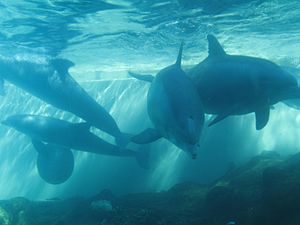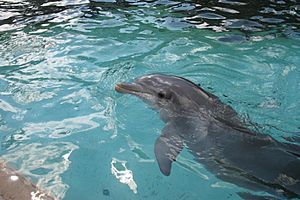Dolphin Cove (SeaWorld) facts for kids
Quick facts for kids Dolphin Cove |
|||||||||
|---|---|---|---|---|---|---|---|---|---|
|
|||||||||
|
|||||||||
|
|||||||||
|
|||||||||
| Ride statistics | |||||||||
| Attraction type | Dolphin exhibit | ||||||||
| Designer | SeaWorld | ||||||||
Dolphin Cove is a special place at SeaWorld parks where you can see and learn about dolphins. It's also called Dolphin Point at SeaWorld San Diego. This amazing habitat holds about 700,000 gallons (2,650,000 liters) of water! You can find Dolphin Cove at SeaWorld Orlando and SeaWorld San Diego.
Dolphin Cove is designed to look like a real ocean home for dolphins. It has a cool underwater viewing area. Here, you can watch the dolphins swim and play. You can even hear their special sounds while relaxing music plays.
This dolphin habitat is one of the biggest dolphin pools anywhere. It lets visitors get up close and even interact with the dolphins. The area has waves that are about 2 feet (0.6 meters) high. It also features a sandy beach and a pretend coral reef.
History of Dolphin Cove Exhibits

The very first Dolphin Cove opened in 1964 at SeaWorld San Diego. It was the first of its kind! Later, in 1970, a second SeaWorld park opened in Aurora, Ohio. This park, SeaWorld Ohio, also had its own Dolphin Cove.
In January 2001, SeaWorld Ohio was sold to another park company called Six Flags. This meant the Dolphin Cove exhibit there closed down.
More recently, SeaWorld San Antonio announced big plans on March 6, 2015. They wanted a brand new dolphin habitat. This new area would also be a place for three animal interaction programs. These programs would feature dolphins, beluga whales, and California sea lions. This exciting new project was named Discovery Point.
Because of this new project, the old Dolphin Cove at SeaWorld San Antonio closed on March 23, 2015. Discovery Point officially opened to visitors on May 21, 2016. This new area is twice as big as the old dolphin pool. It also has an amazing underwater viewing area for everyone to enjoy.
Meet the Dolphins
Most of the dolphins you'll see at Dolphin Cove are bottlenose dolphins. These are one of the most common types of dolphins in the world. The dolphins sometimes move between Dolphin Cove, the Dolphin Nursery, and Discovery Cove. This depends on if they are expecting babies or if more space is needed.
Bottlenose dolphins live all over the world. They especially like warm waters, like the Gulf of Mexico.
Throughout the day, visitors can often feed the dolphins. There is a small fee for this special experience. All the dolphins at Dolphin Cove have names! Some of them are Jenever, C.J., Alpha, Calla, Naia, Griffith, Sparrow, Rascal, Dexter, Sasha, Tasha, and Tinker.
Caring for Dolphins
Some groups are very interested in how dolphins and killer whales are cared for in human habitats. They believe that animals should live in the wild.
SeaWorld works hard to provide good homes for their animals. They have changed how they get their animals over the years. In the past, SeaWorld sometimes captured animals from the wild. However, they stopped capturing dolphins and whales from the wild in 1995.
Today, SeaWorld gets its animals in other ways. They have successful breeding programs. This includes using artificial insemination to help dolphins have babies. They also get animals through loans or by purchasing them from other marine parks around the world. This helps ensure the animals are cared for and contribute to conservation efforts.


